Category Archives: Guadalcanal
“Good Night General Chesty, Wherever You Are.”
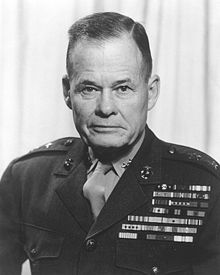 Lewis B. “Chesty” Puller was born in West Point, Virginia to Matthew and Martha Puller. His father was a grocer who died when Lewis was 10 years old. Puller grew up listening to old veterans’ tales of the War Between the States and idolizing Thomas “Stonewall” Jackson. He wanted to enlist in the United States Army to fight in the Border Wars with Mexico in 1916, but he was too young and could not get parental consent from his mother.
Lewis B. “Chesty” Puller was born in West Point, Virginia to Matthew and Martha Puller. His father was a grocer who died when Lewis was 10 years old. Puller grew up listening to old veterans’ tales of the War Between the States and idolizing Thomas “Stonewall” Jackson. He wanted to enlist in the United States Army to fight in the Border Wars with Mexico in 1916, but he was too young and could not get parental consent from his mother.
The following year, Puller attended the Virginia Military Institute but left at the end of his first year as World War I was still ongoing, saying that he wanted to “go where the guns are!” Inspired by the 5th Marines at the Battle of Belleau Wood, he enlisted in the United States Marine Corps as a private and attended boot camp at the Marine Corps Recruit Depot, Parris Island, South Carolina.
Although he never saw action in that war, the Corps was expanding, and soon after graduating he attended NCO school and OCS at Quantico, Virginia, following that. Upon graduation from OCS on June 16, 1919, Puller was appointed to the grade of Second Lieutenant in the Military reserves, but reduction in force from 73,000 to 1,100 officers and 27,400 men following the war led to his being put on inactive status 10 days later and given the rank of corporal.
First Lieutenant Lewis “Chesty” Puller (center left) and Sergeant William “Ironman” Lee (center right) and two Nicaraguan soldiers in 1931
As a corporal, Puller received orders to serve in the Gendarmerie d’Haiti as a lieutenant, seeing action in the United States occupation of Haiti (1915-1934). While the United States was working under a treaty with Haiti, he participated in over forty engagements during the ensuing five years against the Cacos rebels and attempted to regain his commission as an officer twice. In 1922, he served as an Adjutant to Major Alexander Vandegrift, a future Commandant of the Marine Corps.
Puller returned stateside and was finally re-commissioned as a second lieutenant on March 6, 1924, afterward completing assignments at the Marine Barracks in Norfolk, Virginia, The Basic School in Quantico, Virginia, and with the 10th Marine Regiment in Quantico, Virginia. He was assigned to the Marine Barracks at Pearl Harbor, Hawaii, in July 1926 and in San Diego, California, in 1928.
In December 1928, Puller was assigned to the Nicaraguan “Guardia Nacional” National Guard detachment, where he was awarded his first Navy Cross, (military’s second highest valor award) for his actions from February 16 to August 19, 1930, when he led “five successive engagements against superior numbers of armed bandit forces.” He returned stateside in July 1931 and completed the year-long Company Officers Course at Fort Benning, Georgia, thereafter returning to Nicaragua from September 20 to October 1, 1932, and was awarded a second Navy Cross.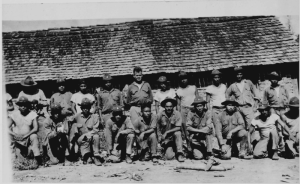
Puller with members of the Guardia Nacional
After his service in Nicaragua, Puller was assigned to the Marine detachment at the American Legation in Beijing, China, commanding a unit of China Marines. He then went on to serve aboard USS Augusta (CA-31), a Cruiser in the Asiatic Fleet, which was commanded by then-Captain Chester W. Nimitz. Puller returned to the States in June 1936 as an instructor at the Basic School in Philadelphia.
In May 1939, he returned to the Augusta as commander of the onboard Marine detachment, and then back to China, disembarking in Shanghai in May 1940 to serve as the executive officer of 2nd Battalion, 4th Marines. He later served as its commanding officer.
World War II
Major Puller returned to the U.S. on August 28, 1941. After a short leave, he was given command of 1st Battalion, 7th Marines (known as 1/7) of the 1st Marine Division, stationed at Marine Corps Air Station New River, North Carolina, the new Marine amphibious base which would soon be renamed for the 13th Commandant of the Marine Corps, John A. Lejeune, Marine Corps Base Camp Lejeune, North Carolina. Early in the Pacific theater the 7th Marines formed the nucleus of the newly created 3rd Marine Brigade and arrived to defend Samoa on May 8, 1942. Later they were redeployed from the brigade and on September 4, 1942, they left Samoa and rejoined the 1st Division at Guadalcanal on September 18, 1942.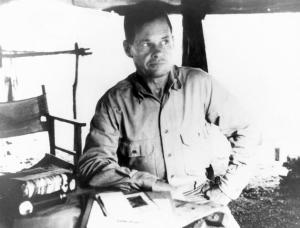
Soon after arriving on Guadalcanal, Puller led his battalion in a fierce action along the Matanikau (September 1942), in which Puller’s quick thinking saved three of his companies from annihilation. In the action, these companies were surrounded and cut off by a larger Japanese force. Puller ran to the shore, signaled a United States Navy destroyer, the USS Monssen (DD-436), and then Puller directed the destroyer to provide fire support while landing craft rescued his Marines from their precarious position. For his actions, he was awarded the Bronze Star Medal with Combat “V”.
Puller on Guadalcanal in September, 1942
Later on Guadalcanal, Puller was awarded his third Navy Cross, in what was later known as the Battle for Henderson Field. Puller commanded 1st Battalion 7th Marines (1/7), one of two American infantry units defending the airfield against a regiment strength Japanese force. The 3rd Battalion of the U.S. Army’s 164th Infantry Regiment (3/164) fought alongside the Marines. In a firefight on the night of October 24–25, 1942, lasting about three hours, 1/7 and 3/164 sustained 70 casualties; the Japanese force suffered over 1,400 killed in action, and the Americans held the airfield. It was in this battle that Marine Sergeant John Basilone would earn the Medal of Honor. The Marines awarded Army Lt. Colonel Robert Hall, commander of the 3/164, the Navy Cross for his role in this battle.
Puller was then made executive officer of the 7th Marine Regiment. While serving in this capacity at Cape Gloucester, Puller was awarded his fourth Navy Cross for overall performance of duty between December 26, 1943, and January 19, 1944. During this time, when the battalion commanders of 3rd Battalion, 7th Marines and, later, 3rd Battalion, 5th Marines, while under heavy machine gun and mortar fire, he expertly reorganized the battalion and led the successful attack against heavily fortified Japanese defensive positions. He was promoted to colonel effective February 1, 1944, and by the end of the month had been named commander of the 1st Marine Regiment. Colonel Puller would lead the 1st Marines into the protracted battle on Battle of Peleliu, one of the bloodiest battles in Marine Corps history during September and October 1944, action where he was awarded his first Legion of Merit. During the summer of 1944, Puller’s younger brother, Samuel D. Puller, the Executive Officer of the 4th Marine Regiment, was killed by a sniper on Guam.
Puller returned to the United States in November 1944, was named executive officer of the Infantry Training Regiment at Camp Lejeune and, two weeks later, Commanding Officer. After the war, he was made Director of the 8th Reserve District at New Orleans, and later commanded the Marine Barracks at Pearl Harbor.
Korean War
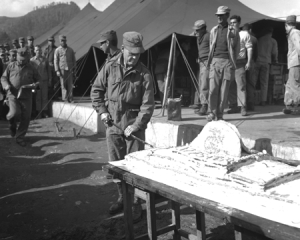 Colonel Puller cutting the Marine Corps birthday cake on 10 November 1950, during a brief reprieve from battle during the Korean War
Colonel Puller cutting the Marine Corps birthday cake on 10 November 1950, during a brief reprieve from battle during the Korean War
At the outbreak of the Korean War, Puller was once again assigned as commander of the 1st Marine Regiment, with which he made a landing at Inchon on September 15, 1950, and was awarded the Silver Star Medal. For leadership from September 15 to November 2, he was awarded his second Legion of Merit. He was awarded the Distinguished Service Cross from the Army for action from November 29 to December 5 of that same year, and his fifth Navy Cross for action during December 5–10 at the Battle of Chosin Reservoir. It was during that battle when he made the famous quote, “We’ve been looking for the enemy for some time now. We’ve finally found him. We’re surrounded. Th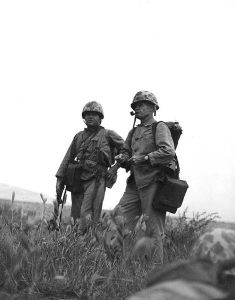 at simplifies things.”
at simplifies things.”
Colonel Puller studies the terrain during the Korean War.
In January 1951, Puller was promoted to brigadier general and was assigned duty as assistant division commander (ADC) of the 1st Marine Division. On February 24, however, his immediate superior, Major General Oliver Prince Smith, was hastily transferred to command IX Corps when its Army commander, Major General Bryant Moore, died. Smith’s temporary transfer left Puller in command of his beloved 1st Marine Division. Puller would serve as ADC until he completed his tour of duty and left for the United States on May 20, 1951.
General Puller subsequently received promotions to major general and lieutenant general, and served in various command capacities until he suffered a stroke from high blood pressure and was forced to retire in 1955.
Puller was a distant cousin to Army General George S. Patton.
He requested to re-enlist so he could serve in Vietnam in 1966, at the age of 68, however, his request was denied because of his age. General Puller was living in Hampton, Virginia at the time of his passing on October 11, 1971, he was 73 years of age.
Awards and honors – Military decorations and awards
Puller received the Navy Cross, the Navy and Marine Corps second highest military award, five times (the second and only other person to be so honored, after Navy submarine commander Roy Milton Davenport). Puller received the second highest U.S. military award six times; five Navy Crosses and a U.S. Army Distinguished Service Cross.
In addition, Puller received the Silver Star Medal; the Legion of Merit with Combat “V” and Gold Star in lieu of a second award; the Bronze Star Medal with Combat “V;” the Air Medal with Gold Stars in lieu of second and third awards; and the Purple Heart Medal. His other medals and decorations include the Presidential Unit Citation Ribbon with four bronze stars; the Marine Corps Good Conduct Medal with one bronze star; the World War I Victory Medal with West Indies clasp; the Haitian Campaign Medal; the Second Nicaraguan Campaign Medal; the Marine Corps Expeditionary Medal with one bronze star; the China Service Medal; the American Defense Service Medal with Base clasp; the American Area Campaign Medal; the Asiatic-Pacific Area Campaign Medal with four bronze stars; the World War II Victory Medal; the National Defense Service Medal; the Korean Service Medal with one silver star in lieu of five bronze stars; the United Nations Service Medal; the Haitian Medaille Militaire; the Nicaraguan Presidential Medal of Merit with Diploma; the Nicaraguan Cross of Valor with Diploma; the Republic of Korea’s Ulchi Medal with Gold Star; and the Korean Presidential Unit Citation with Oak Leaf Cluster.
Puller’s only Purple Heart was earned at Guadalcanal on the night of November 9, 1942 – the night before the Marine Corps Birthday. Puller had campaign participation credit (“battle stars”) for Capture and Defense of Guadalcanal, Eastern New Guinea Operations, Cape Gloucester New Britain, and Capture and Occupation of the Southern Palau Islands (Peleliu). His Korean campaign battle stars include North Korean Aggression, Inchon Landing, Communist China Aggression (Chosin Reservoir), First UN Counteroffensive and Communist China Spring Offensive.
Puller is loved by enlisted U.S. Marines for his constant actions to improve their working conditions. Puller insisted upon good equipment and discipline; once he came upon a second lieutenant who had ordered an enlisted man to salute him 100 times for missing a salute. Puller told the lieutenant, “You were absolutely correct in making him salute you 100 times lieutenant, but you know that an officer must return every salute he receives. Now return them all, and I will keep count.”
He continues to be well loved by those who served under him and after him, because he led from the front and never asked a Marine to do anything he would not do first. It is rumored that he continues to motivate Marines and Recruits at Marine Corps Recruit Depot, Parris Island, South Carolina, where at night you can hear them respectfully say “Good Night, General Chesty, wherever you are.”
Related articles
- More Medals That You Could Shake a Stick at (toptenz.net)
- When will a General lay down his stars and do something about this mess in our Country? (gottalovethenavy.wordpress.com)
- Historic base housing turns 100 (dvidshub.net)
- Marines focus on amphibious roots, Asia-Pacific region (dvidshub.net)
Have We Forgotten Our Heroes? Chapter 22 – Roy Boehm
 LCDR Roy H. Boehm was born in Brooklyn New York. Boehm enlisted in the Navy in April 1941 at the age of seventeen and saw action in the Pacific theater of operation during WWII from February 1942 until the conclusion of the war in 1945. He participated in recovery of corpses and munitions from the USS Arizona while his ship, the USS Duncan, was being repaired and refitted at Pearl Harbor. He is a survivor of one of the largest “all surface” sea engagements of World War II, the Battle of Cape Esperance at Guadalcanal. Boehm was serving on the destroyer Duncan (DD 485) when the ship received fifty-eight 6″ and 8″ shell hits at point-blank range before going down. He saved a teammate from burning to death by jumping in the ocean and later he had to fight off sharks which eventually killed the sailor he saved. Boehm also participated in the following campaigns and engagements: Battle of the Coral Sea, Bouganville, Truk, Green Island, Emeru, Saipan, Tinian, and Guam. He was engaged in supplying ammunitions to the guerrillas in the Philippines and saw action in Kerama Reto and Okinawa. LCDR Boehm also saw action in the Korean conflict and the war in Vietnam.
LCDR Roy H. Boehm was born in Brooklyn New York. Boehm enlisted in the Navy in April 1941 at the age of seventeen and saw action in the Pacific theater of operation during WWII from February 1942 until the conclusion of the war in 1945. He participated in recovery of corpses and munitions from the USS Arizona while his ship, the USS Duncan, was being repaired and refitted at Pearl Harbor. He is a survivor of one of the largest “all surface” sea engagements of World War II, the Battle of Cape Esperance at Guadalcanal. Boehm was serving on the destroyer Duncan (DD 485) when the ship received fifty-eight 6″ and 8″ shell hits at point-blank range before going down. He saved a teammate from burning to death by jumping in the ocean and later he had to fight off sharks which eventually killed the sailor he saved. Boehm also participated in the following campaigns and engagements: Battle of the Coral Sea, Bouganville, Truk, Green Island, Emeru, Saipan, Tinian, and Guam. He was engaged in supplying ammunitions to the guerrillas in the Philippines and saw action in Kerama Reto and Okinawa. LCDR Boehm also saw action in the Korean conflict and the war in Vietnam.
While serving in the US Navy, Boehm attained the following qualifications: unlimited deep-sea diving, deep submergence rescue chamber operator for submarine rescue, experimental diving, and salvage diving. He is a qualified Underwater Demolition Expert, and was test pilot for underwater swimmer propulsion units. Boehm is a graduate of Airborne and Ranger Training. In early 1961, under a Presidential Two priority received from President John F Kennedy, Boehm developed, designed, implemented, and led the Navy’s commando organization known as the SEALs. He was the first Officer in Charge (OIC) of SEAL Team Two.
Boehm assisted in the design and implementation of the Navy’s first counterinsurgency course, for which he received the Navy Achievement Medal. Following this, he was named head of the Navy’s River Patrol Craft Division. There he developed tactical procedures, organized, and trained River Patrol Boat sailors for Operation Gamewarden in Vietnam.
LCDR Roy Boehm is authorized to wear the following medals and awards: Bronze Star with combat “V”, Purple Heart, Meritorious Service Medal, Air Medal, Navy Achievement Medal, Navy Presidential Unit Citation (1942), Navy Meritorious Unit Commendation (1967), Navy Good Conduct Medal with 3 Stars, China Service Medal, American Defense Medal, American Campaign Medal, Asiatic Pacific Campaign Medal w/1 Silver Star/1 Bronze Star/ 1 Arrow Head, Victory Medal WW II, WWII Occupation Medal Navy, National Defense Service Medal with 1 Bronze Star, Korean Service Medal w/2 Bronze Stars, Armed Forces Expeditionary Medal, US Vietnam Service Medal, Philippines Presidential Unit Citation, Korean Presidential Unit Citation, Philippine Liberation Medal, United Nations Korean Medal, United Nations Medal, RVHJ Campaign Medal with Date, USN Expert Rifle Medal, USN Expert Pistol Medal.
Roy Boehm passed away at the age of 84 on December 30, 2008. Roy’s last wish, that his death not be publicized. He wanted no obituary, no funeral service and no fanfare over his death. Boehm was most proud of a plaque mounted on his wall: “Roy Boehm, Man-O-Warsman.” That honor was bestowed on him by the men who served under his command. “It’s the highest compliment you can get,” Boehm had said.
LCDR Roy Boehm is frequently mentioned in Richard Marcinko’s books. Boehm can be seen in the video program “The Tides Of Specwar”. Roy Boehm and Chuck Sasser have written Roy’s autobiography. “FIRST SEAL” is published by Simon & Schuster’s Pocket Books division. It is one of the best autobiographies I have ever read. It was a pleasure to read and was written so one could visualize the actions while reading.
(Some of this information was retrieved on 10.17.2013 from www.navysealteams.com, and Wikipedia, along with my own reading of his autobiography and our private personal correspondence from 2001.)
Recent Comments